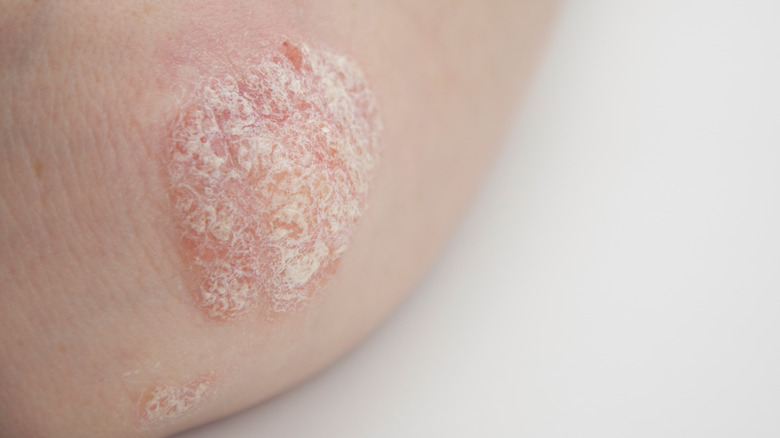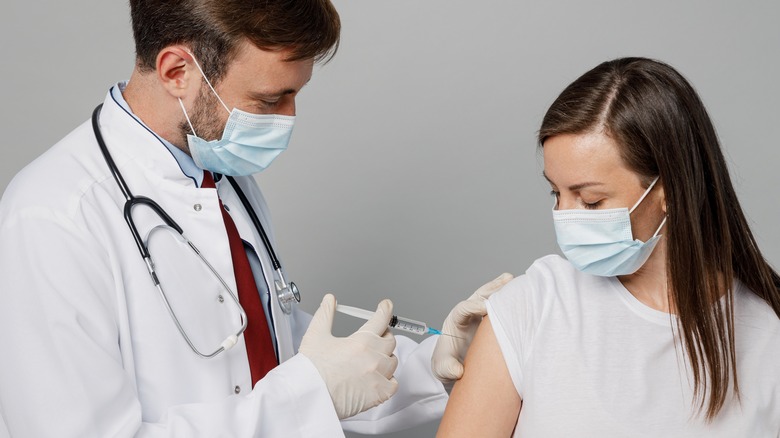Methotrexate Explained: Usage, Dosage, And Side Effects
Gone are the days when we had to rely primarily on plants and other naturally sourced substances to cure diseases. While some of the medicines we have today are derived from those substances, a lot of them are also synthetically produced. Medical News Today says that during prehistoric times, humans rarely lived over 40 years old. Today, most people are expected to live close to 80, although this has been declining in recent years (via Harvard Health).
Many things contribute to us being able to live longer, but advancements in medicine most definitely played a critical role. According to a 2020 study published in Health Affairs, the increase in life expectancy in the United States from 1990 to 2015 can be attributed to better public health practices (45%), drug development (35%), and other forms of medical care (13%), making modern medicine responsible for around 93% of improved life expectancy.
A 2013 article from the Transactions of the American Clinical and Climatological Association recounts that in 1948, Sidney Farber found that a substance called aminopterin was effective in treating leukemia in children. This was later followed by the discovery that aminopterin also interferes with connective tissue proliferation. This prompted scientists to test aminopterin against rheumatoid arthritis, psoriasis, and psoriatic arthritis; they found that the drug significantly improved symptoms. Although aminopterin was clearly beneficial, it caused many side effects and was difficult to manufacture. Because of this, researchers developed a similar drug that was easier to make — and thus, methotrexate was created.
How does methotrexate work?
Following the creation of methotrexate, numerous studies have been done in order to understand how it works, how it affects the body, and what conditions it can help treat. In order for us to understand the significance of methotrexate, we first have to know what it is. According to the National Center for Biotechnology and Information (NCBI), methotrexate is an antimetabolite, a substance that is similar in structure to the building blocks of DNA and/or RNA. Cells, including cancer cells, make use of DNA and RNA to replicate. In the presence of antimetabolites, cells take them up instead of the building blocks they are supposed to, which in turn stops them from replicating.
Methotrexate is a folic acid antagonist, which means that it blocks the formation of folic acid. Specifically, it inhibits the enzyme that converts it to its active form (i.e., tetrahydrofolate or THF), which is a substance that is needed to make DNA and RNA. Through this mechanism, methotrexate is therefore able to prevent cells from multiplying, an effect that is beneficial in the treatment of cancer. Unfortunately, this effect is not specifically targeted towards cancer cells only; normal, rapidly dividing cells such as the bone marrow, fetal cells, lining of the mouth and gut, skin cells, and cells of the bladder may also become affected (per Drugs.com).
Versus Arthritis adds that methotrexate also works by dampening the activity of immune cells, an effect that is very helpful in people with autoimmune conditions.
Methotrexate and rheumatoid arthritis
Rheumatoid arthritis (RA) is an autoimmune disease that causes widespread inflammation. The Centers for Disease Control and Prevention (CDC) explains that people with RA have immune cells that attack certain areas of their body, most commonly the joints (e.g., hands, wrist, knees). Although the cause is unknown, certain people are more at risk of developing RA compared to others. Risk factors include older age, female sex (two to three times greater), having certain genes (i.e., HLA class II genes), smoking, obesity, nulliparity (i.e., no history of giving birth), and certain early life exposures (e.g., having parents who smoke). RA symptoms come and go, but unfortunately, the disease itself is for life. If you have RA, you may experience pain and swelling in your joints, morning stiffness, weight loss, fever, weakness, and fatigue.
The Arthritis Foundation adds that people with RA may also develop eye problems (e.g., dryness, redness, light sensitivity), dry mouth, inflammation of the gums, lumps on the skin, shortness of breath, lung disease, blood vessel inflammation, low red blood cell count, inflammation of the heart, difficulty exercising, weight gain, high cholesterol, diabetes, and high blood pressure. Treatment is aimed at reducing inflammation, relieving symptoms, preventing further joint damage and other complications, and improving overall quality of life. Aside from taking medications (e.g., methotrexate), certain self-care practices can be done to improve pain and joint function, such as proper diet and exercise, hot and cold treatments, pain relievers, reducing stress, and having a good support system.
Methotrexate and psoriasis
Mayo Clinic explains that psoriasis is a long-term, autoimmune skin disease that causes skin cells to grow and divide more rapidly than usual. It runs in the family, which means that you are more likely to get it if one or both of your parents have the disease. Smoking also increases your risk of developing psoriasis, and it can also make the disease worse. If you have psoriasis, you may have flat rashes with silvery scales covering them. The color of the rashes may vary, and can be purple, pink, red, brown, or black.
Your skin may also be prone to bleeding, and it may feel itchy, sore, or painful. These symptoms of psoriasis are not always present. You may have periods of worsening symptoms (i.e., flares) followed by complete resolution (i.e., remission). Certain things in the environment can trigger psoriasis, and these include infections, cold and dry weather, breaks in your skin (e.g., cuts, scrapes, bug bites, sunburn), smoking and exposure to secondhand smoke, heavy alcohol use, rapid withdrawal of medications (specifically steroids), and certain drugs (e.g., lithium, hypertension drugs, antimalarials).
According to Healthline, there are different types of psoriasis, and they differ slightly in their signs and symptoms, as well as the part of the body they primarily affect. Regardless of the type of psoriasis a person has, treatment generally involves topical medicines (creams and ointments like salicylic acid, steroids, and retinoids), systemic medicines (oral or injected drugs like methotrexate), and/or light therapy (ultraviolet light).
Methotrexate and blood cancers
Methotrexate is effective in helping treat certain cancers of the blood because it works by preventing the synthesis of DNA and RNA (which are necessary for cancer cells to divide and spread). It also targets rapidly dividing cells including the bone marrow, where blood stem cells can be found.
Blood cancers that are treated with methotrexate include acute lymphoblastic leukemia (ALL) and non-Hodgkin lymphoma (NHL). According to the American Cancer Society, ALL is a rapidly progressive cancer of lymphocytes, a type of white blood cell that helps the body fight off infections. People with ALL often feel tired, weak, and dizzy; have fever, weight loss, night sweats, appetite loss, shortness of breath, pale skin, and recurrent infections; and are prone to bleeding (e.g., frequent nosebleeds, bruising, heavy menstrual bleeding). Treatment can consist of specialized drugs (e.g., targeted therapy, immunotherapy), chemotherapy (e.g., methotrexate), radiation therapy, surgery, and stem cell transplantation.
On the other hand, NHL is an umbrella term for blood cancers that also involve lymphocytes, but it differs from ALL in that it mostly develops in lymph nodes and other lymphatic tissues (e.g., gut, skin), whereas ALL begins in the bone marrow and may spread to other areas of the body. NHL has similar signs and symptoms as ALL, but the most prominent and distinguishing one is painless swelling of one or more lymph nodes. The types of treatment are also similar to ALL, with methotrexate falling under chemotherapy (via the Leukemia & Lymphoma Society).
Methotrexate and other cancers
According to the National Cancer Institute, methotrexate also works with cancers of the breast, lungs, head and neck, bone (i.e., osteosarcoma), and uterus (i.e., gestational trophoblastic disease).
The treatment for breast cancer depends on its type and how much it has spread. It can involve removing the tumor via surgery, shrinking tumor cells through chemotherapy and/or hormonal therapy, helping the immune system combat cancer cells or control side effects through biological therapy, and killing cancer cells via radiation therapy (per the CDC). Lung cancer (via the American Lung Association), certain types of head and neck cancers (per the Memorial Sloan Kettering Cancer Center), and osteosarcomas (via Mayo Clinic) are treated similarly, with methotrexate being one of the drugs used for chemotherapy.
In gestational trophoblastic disease (GTD), abnormal cells originate in a woman's uterus and grow towards the placenta. There are different types of GTD, but the most common one is called hydatidiform mole (aka molar pregnancy). It begins after implantation of a fertilized egg in the uterus, but instead of the cells developing into a fetus, they proliferate abnormally and become a clump of tissue. Although there is uncontrollable cell growth, most GTDs are benign and can be treated without affecting a woman's fertility. A combination of surgery, chemotherapy, and radiation therapy can be done, but if the disease has spread to other parts, removal of the uterus (i.e., hysterectomy), with or without removal of the fallopian tubes and ovaries, may be necessary (per Cleveland Clinic).
Other indications for methotrexate use
According to MedlinePlus, methotrexate is sometimes given to people with Crohn's disease (CD), multiple sclerosis (MS), and other autoimmune conditions. Versus Arthritis adds that it can also be used in other types of arthritis (e.g., reactive arthritis, vasculitis, myositis, scleroderma).
The National Institute of Diabetes and Digestive and Kidney Disease (NIDDK) states that people with CD are treated based on their symptoms, with the goal of reducing inflammation and preventing flares. Aside from methotrexate, other drugs such as steroids may also be used, in combination with bowel rest, and possibly surgery. For MS, methotrexate is used as an off-label treatment option, according to a 2012 review published in Pharmacy and Therapeutics. More research still needs to be done in order to determine its efficacy and safety. For reactive arthritis (joint inflammation following an infection), Healthline says that methotrexate can be used for those who have had the disease for over six months. It is used to relieve pain, reduce inflammation, and protect the joints from getting further damaged. In vasculitis (blood vessel inflammation), the Johns Hopkins Vasculitis Center states that methotrexate can help decrease the need for steroids, help control the disease, and prevent relapse. For myositis (muscle inflammation), the Myositis Association says that methotrexate is often used to help people wean off of steroids and prevent side effects. With scleroderma, methotrexate is currently not approved in the U.S., but is recommended in Europe for treating skin symptoms early in the disease (via Scleroderma News).
Methotrexate use and getting the COVID-19 vaccine
COVID-19 has been the center of health-related conversations since late 2019. Today, through the efforts of scientists and researchers, we now have four different types of vaccines approved for use in the U.S. (Pfizer, Moderna, Novavax, and Johnson & Johnson's Janssen) for everyone aged 6 months and older. The vaccines are safe for the majority of people, although mild side effects (e.g., fever, chills, fatigue, headache) are common but will resolve on their own after a few days. People who get vaccinated against COVID-19 and are updated with their boosters are less likely to have severe disease, get hospitalized, and die from COVID-19 compared to those who are unvaccinated or those who only got the first two doses (per the CDC).
Although the vaccine is recommended for everyone, people who are severely allergic to the vaccine and/or its components, as well as people who developed myocarditis or pericarditis following a COVID-19 shot, should probably not get the vaccine. On the other hand, people who are immunocompromised (such as those with autoimmune diseases, cancer) should especially get vaccinated, since they are at an increased risk of getting infected. Because methotrexate can decrease the number of immune cells in the body and depress the immune system, getting the vaccine while you are on methotrexate can make the vaccine less effective. Therefore, the American College of Rheumatology (ACR) recommends that methotrexate be held for one to two weeks after each dose of the COVID-19 vaccine.
How should you take methotrexate?
Methotrexate can be taken orally or given via injection (per Drugs.com). Methotrexate injections are typically administered by a healthcare provider, while tablets are prescribed by a doctor and taken by the patient. The amount of methotrexate you need will depend on your age, what disease you are taking it for, how severe your disease is, and how well you are responding to it. For example, for RA, a single 7.5-milligram dose may be taken by mouth or given via injection once a week, or divided into 2.5 milligrams every 12 hours for three doses once a week. For psoriasis, a single 10 to 25-milligram dose (orally or through injection) may be prescribed per week until signs and symptoms improve, or this can be divided into 2.5 milligrams orally every 12 hours for three doses once a week. For ALL, the initial dose begins at 3.3 milligrams based on body surface area (mg/m2) daily for four to six weeks, followed by a maintenance dose of 30 mg/m2 (oral or intramuscular) twice a week or 2.5 milligrams per kilogram (intravenous) every two weeks.
It is important that you take methotrexate for its intended use and exactly as prescribed by your doctor. People with RA, psoriasis, or juvenile arthritis may be given folate (vitamin B9) supplementation to help decrease the risk of vitamin deficiency. If you miss a dose, ask your provider or pharmacist on how to proceed (via Mayo Clinic). If you overdose, seek medical help right away, as this can be fatal.
Methotrexate side effects
Although methotrexate is effective in treating a wide range of illnesses, it is not without side effects. According to the American Academy of Family Physicians (AAFP), adverse effects can be classified as minor or major. Minor side effects occur in 20% to 30% of people taking methotrexate. They are not deadly, and most of them are caused by folate deficiency. Examples include gastrointestinal problems (e.g., nausea, vomiting, diarrhea), stomatitis (inflammation of the mouth and/or lips), fatigue, headaches, mild hair loss, dizziness, fever, muscle aches, and joint pain. On the other hand, major side effects are less common, but may be life-threatening. These include toxicities in the liver (e.g., fatty liver disease, cirrhosis), kidneys (e.g., kidney failure), lungs (e.g., persistent cough, difficulty breathing), and bone marrow (e.g., severe anemia, bleeding, sepsis).
WebMD adds that other common side effects include infections, canker sores, ulcers, bleeding in the gut, decreased appetite, abdominal pain, and a burning sensation on the skin. Less frequent ones include brain disease, lung fibrosis, throat irritation, boils, itching, and skin rashes. Rarely, people may also experience other skin problems (e.g., acne), eye problems (e.g., pink eye, blurry vision, temporary blindness), brain and spinal cord problems (e.g., inflammation, increased pressure, seizures, paralysis), heart problems (e.g., low blood pressure, fluid in the heart, inflammation), blood clots, protein or blood in the urine, fractures, severe allergic reactions, pancreatitis, osteonecrosis (death of bone tissue), ringing in the ears, low sperm count, erectile dysfunction, decreased libido, enlarged breasts, and irregular periods.
Who should not take methotrexate?
Drugs.com warns that there are certain groups of people who should not take methotrexate, as it can cause them more harm than good. These include people who are allergic to the drug and its components, drink excessive amounts of alcohol, have liver cirrhosis or another long-term liver disease, have a weak immune system, have a bone marrow disorder, and women who are pregnant or breastfeeding. Rarely, a doctor may prescribe methotrexate to these groups of people if they also have cancer that is amenable to methotrexate therapy. However, this is typically a last resort, and the benefits of receiving treatment should heavily outweigh the risks.
The AAFP adds that relative contraindications for methotrexate therapy include kidney problems, abnormal liver function tests, hepatitis, lung disease, blood disorders (i.e., low red blood cell, white blood cell, and/or platelet counts), active infections (e.g., tuberculosis, urinary tract infection), HIV or AIDS, and people who are undergoing radiotherapy. MedlinePlus also advises people to talk to their doctor or pharmacist before taking methotrexate. It is important for them to know if you have any allergies to other medications or any of the ingredients contained in methotrexate. You should also tell them about all of the drugs, supplements, and herbal products you are currently taking, so that they can verify if they are safe to consume together with methotrexate. If you are scheduled for any surgeries, including dental work that requires administration of anesthesia, inform your provider that you are on methotrexate.
How methotrexate affects pregnancy
One of the precautions included in the use of methotrexate is to avoid pregnancy. This is because methotrexate may cause harm to unborn babies, and can even lead to their death.
Although this is somewhat a commonly known fact, what people may not know is that if a man is taking methotrexate, he can also cause toxicity to the unborn child, even if the mother is not taking it (per Drugs.com). Therefore, women are advised to have a negative pregnancy test prior to taking methotrexate, and they should take birth control during the whole time they are on the drug, up to at least six months after their last dose. Men also need to use birth control, up to three months after their last dose.
After the overturning of Roe v. Wade, women struggled to find providers that were willing to perform abortions (via Medscape). Suspicions started to arise that they may try to find alternative options. Because of this, important drugs used to treat long-term illnesses that are known to cause pregnancy loss as a side effect became harder to access. Included in these drugs is methotrexate. States that declared abortion as illegal have begun requiring pharmacists to verify that the prescriptions they receive are actually for what it is intended for and not for abortion. According to CNN, some women who have been taking methotrexate to control their diseases are now being restricted by their insurance companies, pharmacies, and doctor's offices.
What you should avoid when you are taking methotrexate
When you are on methotrexate, it may take a while before you notice any changes to your symptoms — possibly up to 12 weeks. Because of this, it is important that you avoid prematurely stopping the medication, and continue taking it as prescribed by your doctor and for as long as they tell you to. This may mean taking it for as long as you are experiencing symptoms, and even after they go away (via Versus Arthritis).
According to Mayo Clinic, you should avoid drinking alcohol while you are on methotrexate, as it can increase your risk of developing liver disease. You should also try to avoid anything that may increase your risk of infections and bleeding, since methotrexate can deplete your blood of white blood cells and platelets. You can do this by avoiding exposure to sick people, checking in with your doctor if you experience any abnormal bruising or bleeding, being more gentle when you brush your teeth or floss, practicing proper hygiene (e.g., avoid touching your eyes or nose, frequent hand-washing), being careful around sharp objects (e.g., razors, nail clippers), and avoiding contact sports. Refrain from getting vaccinations without consulting your doctor, and avoid being around people who have recently gotten a live vaccine. You should also avoid exposure to UV light (e.g., sun, tanning beds, sunlamps) as much as possible. If you are out in the sun, make sure to have adequate sun protection (e.g., sunscreen, sunglasses, UPF clothing).
How other drugs interact with methotrexate
Drugs are primarily cleared from the body through the kidneys or the liver, and sometimes through saliva, sweat, breast milk, and exhaled air (via MSD Manual). Methotrexate is eliminated through the kidneys (per the AAFP). This means that if you have a kidney function problem, they will not be able to filter your blood effectively, which consequently can cause methotrexate to accumulate in your body. Likewise, if you are taking other medications, supplements, or herbal products that are also excreted through the kidneys, they may become overwhelmed and not be able to excrete these substances as efficiently as they normally would be able to. Therefore, preserving kidney function is of utmost importance to avoid adverse reactions when you are on methotrexate.
Drugs.com lists the medications that can interfere with methotrexate elimination. These include oral or intravenous penicillin or sulfonamides, other oral antibiotics, protein-bound drugs (e.g., oral anticoagulants, phenytoin, salicylates, sulfonylureas), probenecid, antifolate drugs (e.g., dapsone, pyrimethamine, pemetrexed), aspirin, other nonsteroidal anti-inflammatory drugs (NSAIDs), products toxic to the liver and/or the kidneys, and proton pump inhibitors. When these drugs are co-administered with methotrexate, the risk of developing major toxicities increases, and may even decrease the efficacy of methotrexate. If people on methotrexate must take any of these drugs, they should be monitored very closely for side effects. In addition, nitrous oxide (inhaled anesthetic commonly used in dental procedures and emergency centers) amplifies the effect of methotrexate, which can also increase the risk of severe toxicity.
How to store and dispose methotrexate
Oral methotrexate is given as round, yellow, 2.5-milligram tablets that are scored (indented in the middle to help people divide the tablet in half). "LP" is printed above the score, and "22" is printed below. They should be kept in an airtight, light-resistant container with a child-proof cap, and should be stored at 68 to 77 degrees Fahrenheit (per Drugs.com).
Remember that pill organizers are not child-proof. If you are using one, make sure that it is in a location that is unreachable to young children. If you no longer need to take this drug, dispose of it in a way that makes sure pets, children, or other people will not be able to get a hold of it. The best way to do so is through a medicine take-back program, or you can ask your pharmacist what you should do (via MedlinePlus). Do not flush methotrexate tablets down the toilet.
On the other hand, methotrexate in injection form is a clear, yellow solution contained in vials. Solutions with and without preservatives are available (per Pfizer). Vials with preservative are multi-dose, which means that each vial contains enough amounts of methotrexate for multiple doses. Each vial contains 50 milligrams per 2 milliliters. Vials without preservative are single-dose vials, and contain 1 gram per 40 milliliters. They should be stored at around 68 to 77 degrees Fahrenheit, but multiple-dose vials that have already been punctured should be stored at 36 to 47 degrees Fahrenheit and used within 30 days.















